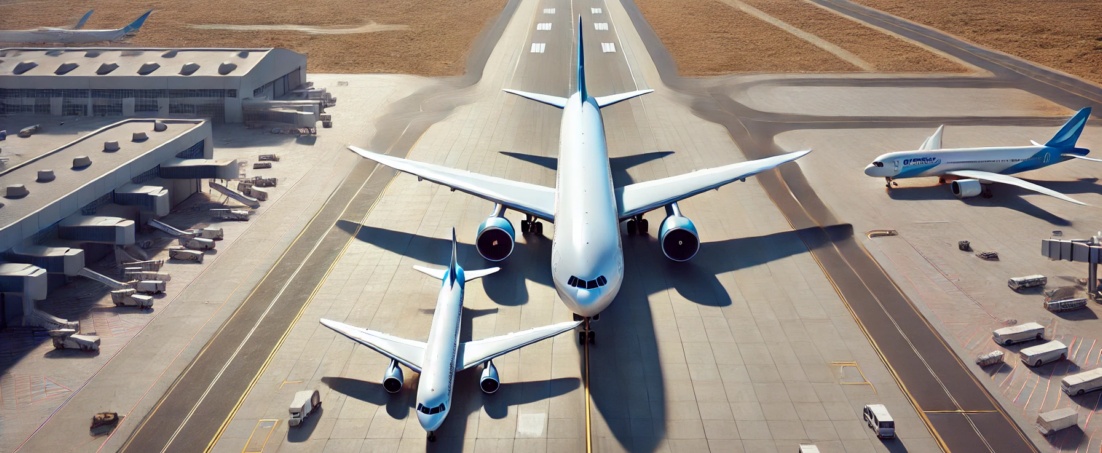Airbus A320 vs. Boeing 777

The Airbus A320 and Boeing 777 are among the most popular aircraft models in the aviation industry, but they are designed for different purposes and vary in many ways. Here are the key differences between the Airbus A320 family and the Boeing 777!
Airbus A320: Designed for short- and medium-haul flights, the A320 family bridges the gap between regional and intercontinental flights. The A320 family typically consists of four main models (A318, A319, A320, A321) with a passenger capacity range of 100-240.
Boeing 777: The Boeing 777 is a long-range, wide-body aircraft favored for intercontinental and transatlantic flights due to its large passenger capacity and extensive range. The Boeing 777 can carry 300-450 passengers, making it ideal for high-capacity routes.
Airbus A320: The A320 is a narrow-body (single-aisle) aircraft commonly used in economical flights. Its cabin width is approximately 3.70 meters, allowing for a single-aisle layout that maximizes passenger capacity.
Boeing 777: The Boeing 777 is a wide-body (twin-aisle) aircraft with a double-aisle layout that accommodates a larger passenger capacity. Its cabin width is around 5.86 meters, providing a more spacious interior for passengers.
Airbus A320: The range of the A320 family varies by model. Newer models, like the A320neo, offer a range of up to 6,300 km, while long-range versions such as the A321LR and A321XLR are ideal for longer routes, although still best suited for regional and intercontinental flights.
Boeing 777: The Boeing 777 has an extensive range. The 777-200LR model, for example, can fly up to 15,000 km, making it one of the longest-range aircraft in the world. This range makes the 777 ideal for direct routes such as New York to Sydney or Dubai to Los Angeles.
Airbus A320: The A320 series is optimized for medium-scale flights with a passenger capacity of 100-244. Frequently used on short and medium-haul routes, the A320 family is a common choice for low-cost airlines.
Boeing 777: With a capacity of 300-450 passengers, the Boeing 777 can accommodate a much larger passenger group. Suitable for long-haul flights, the 777 offers a high-capacity layout with economy, business, and first-class seating options.
Airbus A320: The A320 family is equipped with smaller, fuel-efficient engines. With options such as the CFM56, IAE V2500, Pratt & Whitney PW1100G-JM, and CFM International LEAP-1A (A320neo), the A320 excels in fuel efficiency, especially for short-haul flights.
Boeing 777: The Boeing 777 is equipped with some of the world’s most powerful commercial jet engines. The GE90 engines provide high-speed, long-range performance. The GE90 engine also has one of the largest diameters among commercial jet engines, designed for power and efficiency on long-haul flights.
Airbus A320: The Airbus A320 family, especially the A320neo series, stands out in terms of fuel efficiency and low carbon emissions. The A320neo offers 15-20% reduced fuel consumption, making it an eco-friendly choice, particularly for short-haul routes.
Boeing 777: Although the Boeing 777 is a wide-body aircraft, it is still fuel-efficient on long-haul flights. New-generation models like the Boeing 777X are designed to achieve even lower fuel consumption and longer range, though naturally, its fuel use is higher than that of a narrow-body aircraft like the A320.
Airbus A320: Among narrow-body aircraft, the A320 provides a comfortable flight experience with spacious seat arrangements, large overhead bins, and quiet engines. Primarily designed as a single-aisle aircraft, the A320 is ideal for regional flights.
Boeing 777: The Boeing 777 offers a spacious cabin, wide seats, high ceilings, and a roomy interior on long-haul flights. With a double-aisle layout, passengers have greater freedom to move around on long flights, and the aircraft’s large overhead bins and windows enhance comfort.
Airbus A320: The A320 family is ideal for low-cost airlines and short- to medium-haul routes worldwide. Leading airlines such as American Airlines, easyJet, Ryanair, and Turkish Airlines frequently opt for this model.
Boeing 777: The Boeing 777 is widely used on long-haul routes by premium international airlines like Emirates, Qatar Airways, and Singapore Airlines. With its high passenger capacity and luxury cabin options, the 777 is a preferred choice for intercontinental flights.
Airbus A320: The A320 family helps airlines reduce operational costs due to its low operating expenses and fuel efficiency. Its suitability for medium-range flights makes it a cost-effective choice.
Boeing 777: The Boeing 777 offers a cost advantage on long-haul flights due to its high passenger capacity. However, as a larger, more powerful aircraft, its operating costs are higher than the A320, making it less economical on shorter routes.